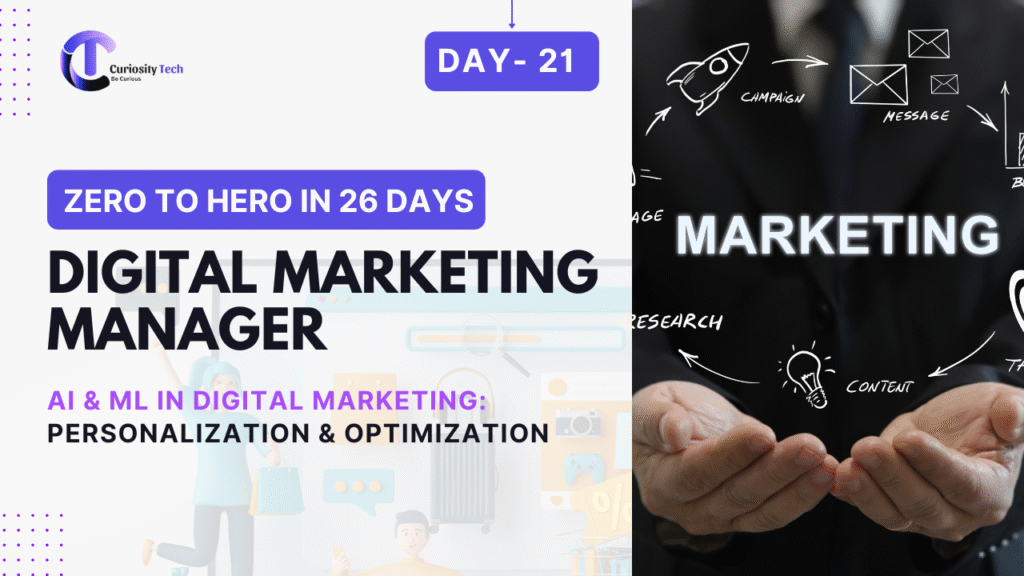(Format: Comprehensive Deep-Dive + Stepwise Strategy + Real-World Examples + Infographic/Visual Flow + Practical Implementation Guidance)
Introduction
- The digital marketing landscape in 2025 is no longer driven solely by intuition or creative hunches—it’s powered by Artificial Intelligence (AI) and Machine Learning (ML). From personalized recommendations to predictive analytics, AI and ML are enabling marketers to deliver the right message to the right person at the right time.
- At CuriosityTech.in, located at 1st Floor, Plot No 81, Wardha Rd, Gajanan Nagar, Nagpur, we’ve implemented AI-driven campaigns for brands across e-commerce, SaaS, B2B, and local businesses. The results? Enhanced engagement, increased conversion rates, and measurable ROI improvements.
- In this blog, we will cover everything you need to know about AI & ML in digital marketing, including:
- ● How personalization works
- ● Types of AI & ML applications in marketing
- ● Stepwise implementation strategy
- ● Real-world case studies
- ● Tools, dashboards, and analytics
- ● Best practices to become an AI-driven marketer
Understanding AI & ML in Digital Marketing
- Artificial Intelligence (AI): The simulation of human intelligence in machines to perform tasks that usually require human cognition—like predicting behavior, understanding language, or identifying patterns.
- Machine Learning (ML): A subset of AI where algorithms learn from historical data to make predictions or decisions without explicit programming.
- In digital marketing, AI & ML are primarily used to:
- Personalize User Experience: Tailor recommendations, offers, and content for individual users.
- Predict Customer Behavior: Identify potential leads likely to convert or churn.
- Optimize Campaigns: Automatically adjust ad spend, targeting, and content distribution.
- Automate Repetitive Tasks: Chatbots, email workflows, social media posting.
- Attack: Finance app stores tokens in plain text /data/local/tmp.
- Forensic Trace: Root analysis reveals exposed credentials.
- Impact: Session hijacking = stolen banking access.
Case Example 3 – Network-Level Sniffing
- Attack: Victim connects to rogue Wi-Fi. Attacker intercepts all HTTP unencrypted requests.
- Forensic Trace: Captured packet dumps containing usernames/passwords via Wireshark.
- Impact: Identity theft.
How Personalization Works
Personalization is the cornerstone of AI-driven marketing. It involves delivering relevant experiences based on user data, behavior, and preferences.
- User browsing history
- Purchase behavior
- Geolocation and device data
- Interaction with emails, ads, or content
Step 2: Segmentation & Clustering
- AI algorithms group users with similar behavior patterns.
- Example: K-Means Clustering → Grouping users who purchase skincare every 30 days.
Step 3: Predictive Recommendations
- ML models predict the next best action, such as:
- Product recommendations
- Content suggestions
- Dynamic pricing offers
Step 4: Automated Delivery
- Personalized emails, app notifications, website pop-ups, and retargeting ads.
Stepwise Strategy to Implement AI & ML
Step 1: Identify Goals
- Increase CTR on campaigns
- Reduce cart abandonment
- Improve customer lifetime value (CLV)
Step 2: Choose the Right Tools
HubSpot AI → Lead scoring & predictive workflows
Mailchimp / Klaviyo AI → Email personalization & predictive content
Google Ads Smart Bidding → Automatically optimize bids based on likelihood of conversion
Dynamic Creative Optimization tools → Auto-adjust visuals, copy, and offers
Step 3: Data Infrastructure Setup
- Integrate GA4, CRM, e-commerce platform (Shopify/WooCommerce)
- Collect behavioral, transactional, and demographic data
Step 4: Build ML Models / Use Pre-Built AI Engines
- For small businesses: Use pre-built AI features in HubSpot, Klaviyo, or Shopify
- For enterprise: Custom ML models predicting churn, LTV, or purchase propensity
Step 5: Continuous Learning & Optimization
IAI models improve as data grows
Run A/B tests, measure uplift, and feed results back into models
AI & ML Applications in Marketing
| Application | Description | Example |
| Predictive Analytics | Forecast user actions like churn or purchase | Retail store predicts next product a customer may buy |
| Chatbots & Virtual Assistants | 24/7 automated customer support with contextual understanding | Website chatbot guiding users through checkout |
| Dynamic Pricing | Adjust prices in real-time based on demand, competition, and behavior | E-commerce flash sale pricing |
| Content Recommendations | Suggest articles, blogs, or videos based on user behavior | YouTube suggested videos or blog widgets |
| Ad Targeting & Retargeting | AI automatically optimizes ads for users most likely to convert | Google Smart Display campaigns |

AI-Driven Marketing Workflow (Infographic Description)
Tools & Platforms Recommended
● HubSpot AI: Lead scoring, email personalization, automated workflows
● Klaviyo / Mailchimp AI: Predictive content and send-time optimization
● Google Ads Smart Campaigns: ML-driven bidding, targeting & ad personalization
● Zapier + AI integrations: Connect multiple apps for workflow automation
● ChatGPT / GPT-powered Bots: Customer support & content generation
Becoming an Expert in AI & ML Marketing
1. Understand Data: GA4, CRM databases, and event tracking
2. Learn Algorithms at High Level: Clustering, regression, and prediction models
3. Get Hands-On Tools: HubSpot AI, Klaviyo, Google Ads Smart Bidding
4. A/B Test & Optimize: Always validate AI predictions with real-world testing
5. Stay Updated: AI in marketing evolves rapidly—follow industry reports and case studies
Challenges & Best Practices
| Challenge | Best Practice |
| Lack of quality data | Implement structured data collection early |
| Over-automation & loss of human touch | Blend AI recommendations with human oversight |
| Model biases & errors | Continuously audit and retrain AI models |
| Compliance & privacy | Follow GDPR, India PDPB, and opt-in regulations |
Conclusion
AI and ML are transformational technologies in digital marketing. They allow businesses to:

